45 standard labels for chemical containers
Rules for Proper Secondary Container Labeling - HSI The most recent revision of the Hazard Communication System aligns U.S. hazardous chemical labeling standards with those of the international GHS labels (Globally Harmonized System of Labeling and Classifications), making it easier for everyone to understand the hazards related to chemicals nationally and internationally. Though hazardous chemical label requirements dictated by GHS have been made clear, many are still confused about how and if requirements for secondary container labels have ... A Guide to OSHA's New GHS Chemical Labeling Requirements The GHS-inspired standards will require chemical manufacturers and importers to label chemical containers with 1) a harmonized signal word 2) GHS pictogram (s) 3) a hazard statement for each hazard class and category and 4) a precautionary statement. These elements are discussed in greater detail below:
Global GHS Label Size Requirement 2019 - chemsafetypro.com The dimension of a GHS label shall be related to package sizes; The minimum size of a pictogram on a GHS label shall be related to the minimum size of the GHS label; The minimum size of a GHS pictogram on a GHS label is usually much smaller than a transport pictogram (100mm x 100mm); A GHS label must be legible and prominently displayed;

Standard labels for chemical containers
Proper Labeling Chemical Containers - Hazcom ... - OSHA Review OSHA requires every original chemical container to have a primary shipping label from the manufacturer with a few exceptions: Drugs for patient care, consumer chemicals, and pesticides, including disinfectants and dental unit waterline cleaners, are not subject to the labeling requirements. The chemical manufacturer must ensure that primary label is marked with the following information: Container Labeling | Office of Environmental Health and Safety | ECU Labels of incoming manufactured products or chemicals must contain 6 key elements: Signal Word Pictograms Manufacturer Information Precautionary Statement(s) Hazard Statement(s) Product name or identifiers OSHA requires that labels on incoming containers of hazardous materials must not be removed or defaced until the container is empty and rinsed. Proper Labeling Of Chemical Containers Chemistry Chemical Container Labels | EHS 2 weeks ago washington.edu Show details . Containers with peroxide-forming chemicals, such as those listed below and discussed in Section 2 in the UW Laboratory Safety Manual or those with an SDS that states the chemical can form peroxides, must be labeled with the UW 1716 label shown and indicate the date the original container was first opened.
Standard labels for chemical containers. PDF Chemical Labeling Guidelines - UGA 2.0 STANDARDS: 2.1: Labeling is not required of secondary containers which are intended only for the immediate use of the person who mixes the chemical or performs the transfer from the original labeled container. 2.2 All secondary chemical containers can have a National Fire Protection Agency (NFPA) PDF HEALTH & SAFETY Chemical Container Labeling Label information must be legible and in plain English. 5 Chemical identity and hazard warning should already be printed on the manufacturer's container. 6 Recommended for best practices, though not required per regulation. 7 Required for chemicals that degrade over time, peroxide formers, and air and water reactives. Chemical Labeling Abbreviations Guidelines for Labelling of Hazardous Chemicals - Dosh 1.1 These guidelines may be cited as the "Guidelines for Labelling of Hazardous Chemicals". 1.2 For the purpose of these guidelines, labelling is the process where a supplier of hazardous chemicals affix a label onto a packaging containing information about the hazardous chemicals contained within the packaging. Reference Guide to GHS Container Labels - UArizona Research, Innovation ... There are six required sections of a GHS-compliant chemical container label: Product Identifiers GHS Pictograms Signal Words Hazard Statements Precautionary Statements Supplier Identification 1. Product Identifiers The product identifier is most often the common product name of the chemical, and must match the product identifier on the SDS.
Labeling secondary containers - JJKellerSafety.com If the chemical is going to be used only "in house," then the container is to be labeled in accordance with 1910.1200 (f) (6) . Label it with the product identifier, words, pictures, symbols, or a combination thereof. You can use HMIS or NFPA labels, or your own system, for in-house container labels as stated in 1910.1200 (f) (7). Information on hazardous chemical labels | Safe Work Australia A hazardous chemical is correctly labelled if it is packed in a container and has a label written in English. Pictograms and text on the label should be clear. The label must also be firmly fixed to the hazardous chemical's container. It should not be hidden or in a spot where it could be removed, such as on the lid. The label must include the: Chemical Hazardous Waste Containers: EPA and DOT Labeling Requirements A container used for chemical hazmat onsite storage must be marked with the words "Hazardous Waste." It must also exhibit the starting date for its accumulation along with information about its contents (e.g., toxic, reactive, ignitable, or corrosive). If you're reusing a container, make sure to remove the old labels. GHS Labeling Requirements: The Definitive Guide [2021 Update ... - Luminer Primary Containers Primary chemical containers include: Bags; Cans; Bottles; Cylinders; Barrels; Drums; Boxes; These are the types of containers that are used to transport chemicals from the manufacturers. They should include all the relevant GHS requirements we covered above. Labels provided by suppliers should never be removed, modified, or defaced.
6 Tips to Ensure GHS Compliance for Smaller, Down-Packed Chemical ... 1) Have GHS-compliant safety data sheets and labels and train workers to handle hazardous chemicals properly. On each GHS label, six items of data are required: product name or identifier, hazard statement, signal word, GHS pictogram symbols, a precautionary statement and supplier information. Labels On Chemical Containers Chemistry Nov 07, 2019 · Chemical Container Labeling. The Hazard Communication Standard (HCS) describes chemical labels as information provided through a group of written, printed, or graphic appropriate elements concerning a hazardous chemical. These should be that placed on the immediate container of a hazardous chemical. The Hazard Communication ... Chemical Container Labels | EHS - University of Washington The Hazard Communication Standard requires secondary chemical container labels contain at least the following information: Identity of the contents (spell out chemical names) Signal word, if known or suspected (e.g., "danger", "warning") Hazards, if known or suspected (e.g., "flammable", ... PDF ENVIRONMENTAL HEALTH & SAFETY Chemical Container Labeling Summary of OSHA standards and labeling requirements for Hazardous Chemical Containers. Laboratory Areas & Use Non-Laboratory Areas & Use (machine shop, paint shop, etc.) Required Label Information . 1. Manufacturer's container. 2. Secondary container. 3. Manufacturer's container Secondary container. Chemical Identity . 4. Required 5 Required ...
GHS Labeling Requirements - Guide to GHS Chemical Labels Keep containers tightly closed and store in well-ventilated areas. Ground and bond both the container and receiving equipment. Do not eat or drink when using this product. Highly flammable vapor; may cause kidney damage. In case of fire, use a carbon dioxide extinguisher.
4 Quick Tips to Help You Ace OSHA Secondary Container Labeling Tip #2: Play it Safe with GHS Labels for All Chemical Containers. OSHA HazCom standards allow for some limited flexibility when labeling secondary containers. For example, there are six clear elements required for primary containers but less strict, more nuanced specifications for secondary containers. It's important to note that the less ...
GHS Labels for Secondary Containers | HCL Labels, Inc. HCL Labels, Inc. offers a library of over 800 ready-made chemical GHS labels for secondary containers. GHS-labeled secondary containers are required by state and federal law to be labeled with a GHS Safety label, indicating which chemical is in use. HCL Labels offers GHS Labels in various sizes, formats, and multilingual options.
Download secondary chemical container labels | EHS If your laboratory uses secondary containers filled with chemicals, the secondary containers must comply with OSHA's Hazard Communication Standard for Labels and Pictograms. For your convenience, EH&S designed secondary chemical labels that can be downloaded from our website and printed onto Avery 5163 labels. You may choose from three designs:
Labeling of Secondary Containers | Occupational Safety and Health ... Section 1910.1200(f)(6)(ii) requires that workplace labeling include "product identifier and words, pictures, symbols, or combination thereof, which provide at least general information regarding the hazards of the chemicals, and which, in conjunction with the other information immediately available to employees under the hazard communication program, will provide employees with the specific information regarding the physical and health hazards of the hazardous chemical."
Chemical Labels | label.co.uk - etikett.de Labels for Chemicals; Roll Labels Polypropylene (PP) and polyethylene (PE) roll labels Labels for chemicals must be resistant to particular stresses so that they remain adhesive and clearly legible for as long as the container is in use.
Secondary Container Labels 101: HazCom and WHMIS - ERA Environmental The standards are in effect to prevent any cases where uncertainty of the handled material could jeopardize the health and safety of anyone on site. ... Even better is to use a system that automates the entire SDS authoring and Secondary Container Label authoring - one chemical database, built-in templates, complete hazard determinations, and ...
Labeling of small containers in the laboratory | Occupational Safety ... Different sizes of containers of hazardous chemicals are used. The larger 16-ounce bottles of hazardous chemicals are dispensed into four 4-ounce bottles. The primary bottles are properly labeled; however, you state that due to the small size of the 4-ounce bottles, applying all of the HCS 2012 information is impossible.
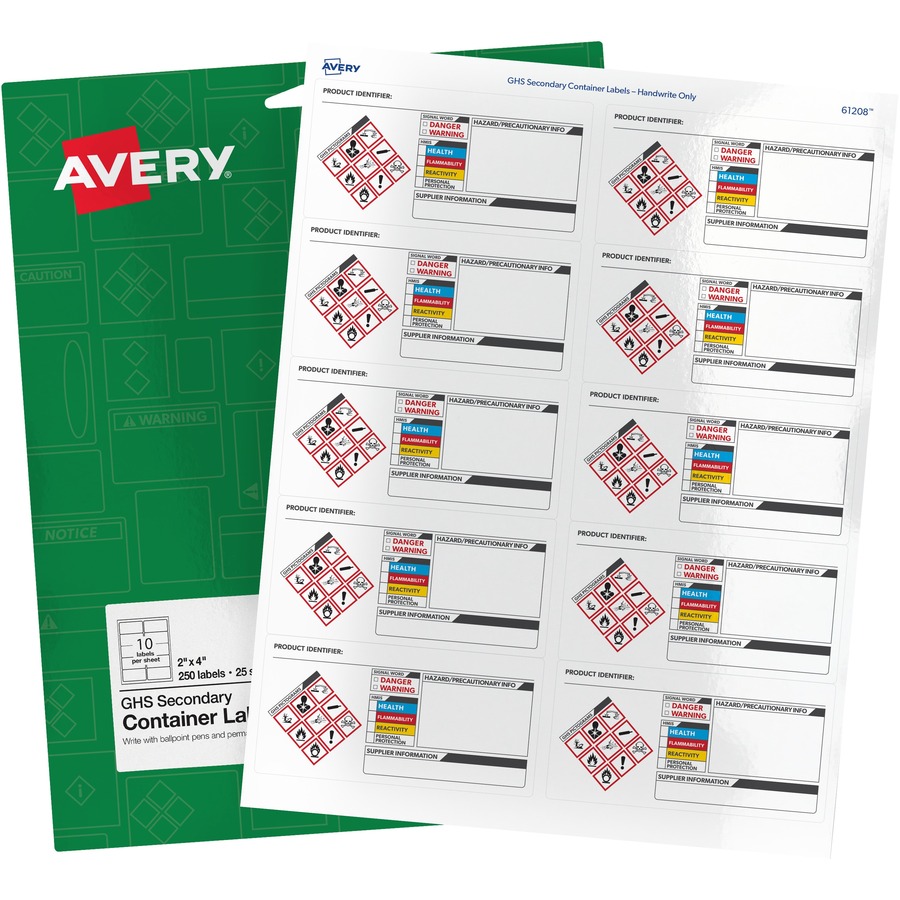
Avery® GHS Secondary Container Preprinted Labels - "DANGER" - Permanent Adhesive - Rectangle - Assorted - Film - 10 / Sheet - 125 Total Sheets - 1250 ...
GHS Label Requirements, Guidelines, and Best Practices OSHA adopted GHS label requirements into their Hazardous Communication Standard (HCS) at the end of 2009. From there, it took years of work to revise regulations and implement GHS into OSHA's Hazardous Communication (HazCom) regulations. The first GHS standards were introduced in HazCom 2012, and were fully implemented by OSHA in 2016.
Storage Tanks: Labeling Requirements - Bluefield Process Safety While OSHA takes great pride in stating that its regulations are performance-based, the labeling requirements for shipping containers are quite prescriptive. There are six. Labels for shipping containers must include: Product identifier. Usually the name of the chemical, but it could be a code. Signal word.
Proper Labeling Of Chemical Containers Chemistry Chemical Container Labels | EHS 2 weeks ago washington.edu Show details . Containers with peroxide-forming chemicals, such as those listed below and discussed in Section 2 in the UW Laboratory Safety Manual or those with an SDS that states the chemical can form peroxides, must be labeled with the UW 1716 label shown and indicate the date the original container was first opened.
Container Labeling | Office of Environmental Health and Safety | ECU Labels of incoming manufactured products or chemicals must contain 6 key elements: Signal Word Pictograms Manufacturer Information Precautionary Statement(s) Hazard Statement(s) Product name or identifiers OSHA requires that labels on incoming containers of hazardous materials must not be removed or defaced until the container is empty and rinsed.
Proper Labeling Chemical Containers - Hazcom ... - OSHA Review OSHA requires every original chemical container to have a primary shipping label from the manufacturer with a few exceptions: Drugs for patient care, consumer chemicals, and pesticides, including disinfectants and dental unit waterline cleaners, are not subject to the labeling requirements. The chemical manufacturer must ensure that primary label is marked with the following information:




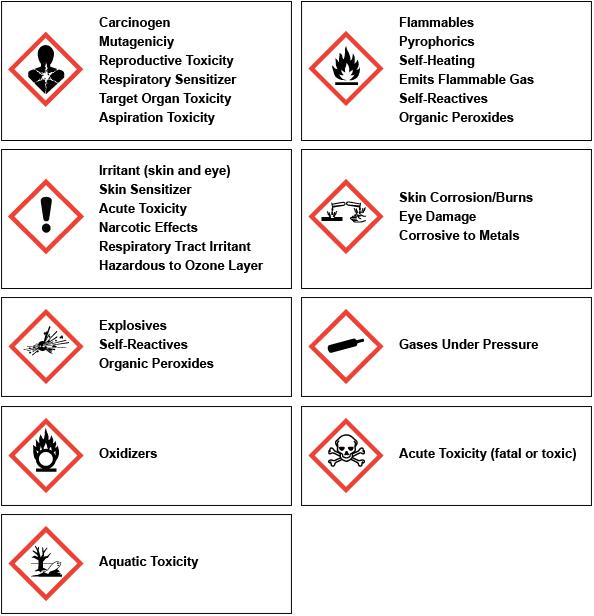

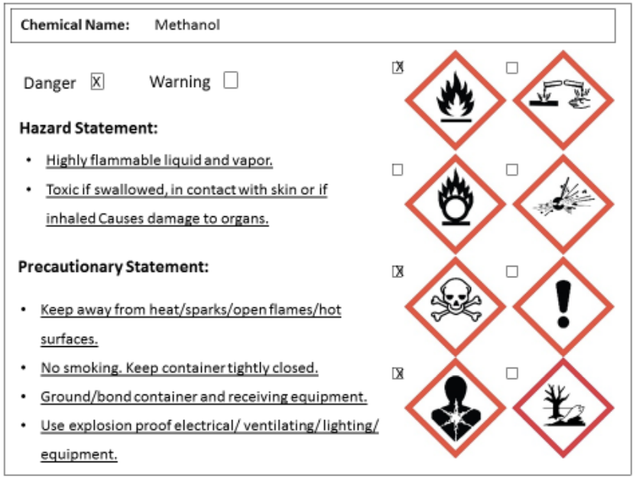





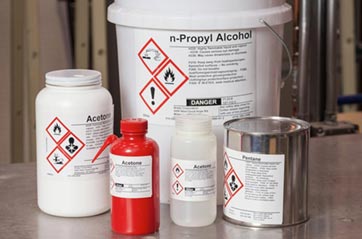






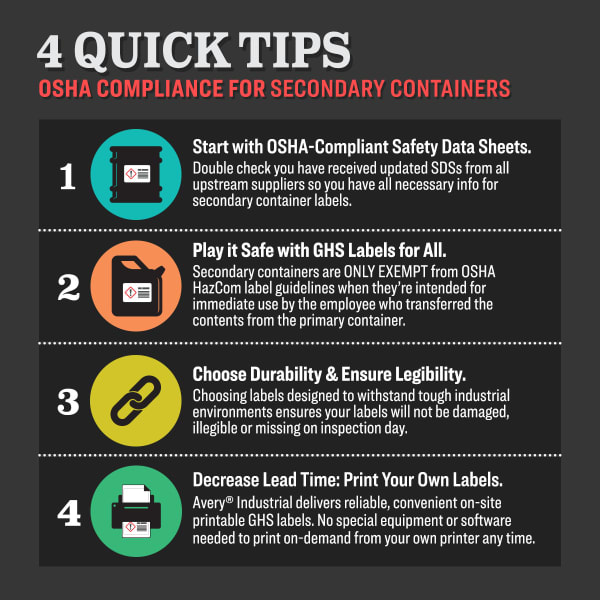

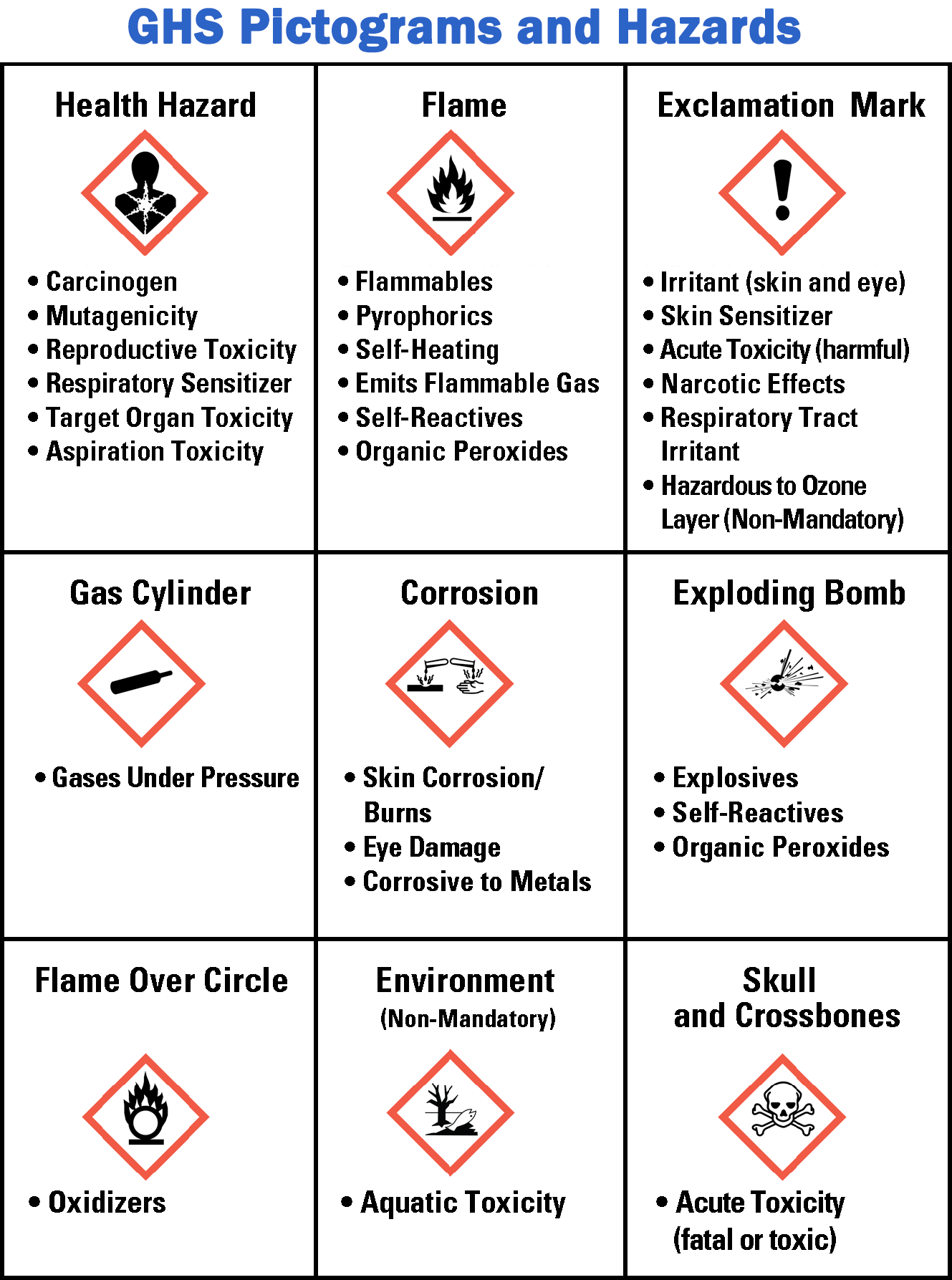


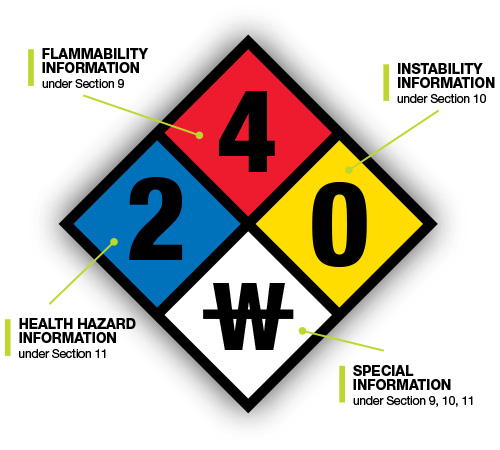

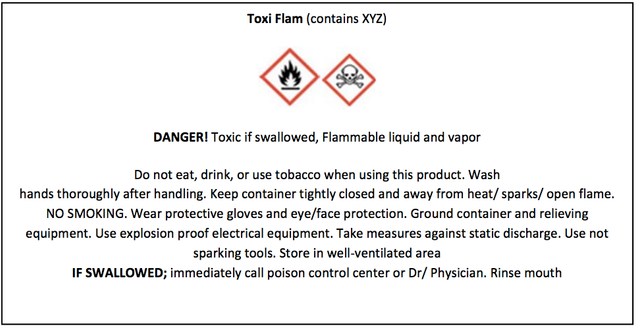







![New OSHA Hazard Communication Regs [What Employers Need to Know]](https://cdn2.hubspot.net/hub/38664/file-31592697-jpg/images/oshahazardcommunicationstandardpictograms2.jpg)


Post a Comment for "45 standard labels for chemical containers"